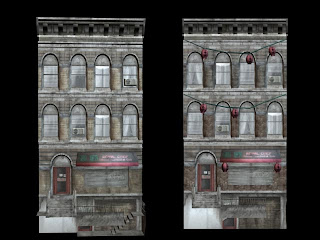With my Visual design work, it was mostly a case of getting up to date with the work we had been set so far, which I managed catch up on over the Christmas holidays. Also, with a lot of the work I showed Chris, I had done it all traditionally so with any changes that could be made it was suggested that I do them digitally once I had them scanned in. This is the case with my Abbey Park final shown below:
Even though im not completely done editing it, here is how I've changed it so far: turned the contrast down slightly, by adding darker shades to the piece, mostly to the right corner as this is overly bright in my original painting and shows not much form underneath the light reflection. I've also tried to make more of an emphasis on the bridge centre piece as this is the focal point of my painting.
This is one of the pieces I did of abbey park leading up to the final, and was my focus on using colour that I am concentrating on this year. It was suggested that to make the object of the bridge closest to the viewpoint, that I make a copy of my original painting and got over it with a fine line pen, to enhance the edges of the solid objects.
A piece that I completed over Christmas, from the original pencilled line art, I am really pleased with how this came out. I think it is the most accurate use of colour and lighting in a painting I have done so far. The only thing that niggles me about it, is that the shapes of the circular components of the train are not completely accurate, as they were an area I struggled to get right. I will probably try to adjust the front of the train digitally, later on.
With a lot of the work I did over Christmas, the Leicester sketches I did probably were the best at showing how far I've improved, as I did them in precision fine line pens and permanent media such as these are media in which I tend to do well in. This combined with a watercolour wash, is a technique in which I will focus on for future works, as the end result is one I am very satisfied with.
Initial sketches done for 'War of The Worlds' project, according to my tutor, the loose lines worked quite well on some of these sketches even though when approached with an open project like this I find it quite hard sometimes to be so loose flowing with my pencil strokes as my head full of ideas, gets in the way of just putting pencil to paper.
A final painting for my 'War of The Worlds', depicting my 'tripod' design. As a rough painting, it still needs a lot of work and more details adding, which i will most likely do digitally later.
Overall my visual design has greatly improved, and with more projects that involve freedom im finding that im getting into the flow more, as im having more fun at letting my imagination kick in. One thing that was noticeable was my lack of confidence in pencil, compared to my work with pens, so it was suggested i experiment with various mechanical pencils to try and get an ideal pencil to translate my strokes. I think the next step from here, is to approach painting digitally in the next project, as my work is still focused mainly on traditional, as im stubbornly stuck firmly in that area :p













